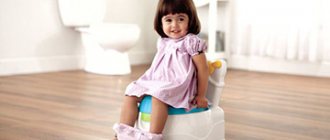Why does a baby like to jump when he is held by the arms? Because his whole body is preparing to stand on its feet. While the baby cannot yet stand on his own, the body muscles are trained during such a children's dance. When does a child begin to stand on his own? Let's learn about this from the article.
Physical development of the baby
Observant mothers notice how a baby from the age of five months begins to train his feet, doing real gymnastic exercises on his own: he turns his feet to the right/left in a figure eight while lying in the crib.
Then, at six months, the baby gets on all fours and rocks his body back and forth, cheerfully pronouncing his favorite sounds: yes, yes, yes, ma-ma-ma. What it is? This is strengthening the back muscles, preparing for standing on your feet. Crawling on all fours also helps strengthen the back muscles.
At the same time, a six/seven month old baby loves to jump when his parents lift him by the arms and hold him in a standing position. The child does not want to just stand: he needs to jump cheerfully and babble his first children's words, understandable only to his mother and himself. This exercise trains the flexor and extensor muscles.
The baby’s physical education doesn’t end there: he grabs the crib with his hands and, trembling all over, tries to stand on his own feet! And he does this with enviable persistence, constantly. So, his time has come! He gets up, lets go of his hands, falls on his butt and gets up again. Don't stop him from doing this!
And that's not all: the child tries to move along the crib, holding on to the railing. He really likes this activity. The baby can happily walk around the crib, accompanying his actions with cheerful babble - as much as he likes!
When do babies start crawling?
The question of how many months a child should crawl is incorrect. In fact, the baby doesn't owe anyone anything. Yes, there are average indicators, but kids are not familiar with them, so they develop at their own pace.
Let us present only general data. On average, babies begin to crawl at 7 months of age, but the time frame for the development of this skill is quite wide - from 5 to 9 months. Pediatricians also note that girls are often a month or two ahead of boys.
Typically, a child learns to crawl after he learns to sit on his own, since the spinal column is already strong enough to move to the stage of full movements. Interestingly, some babies skip crawling altogether and immediately stand on their feet.
In addition, the answer to the question of how many months a child begins to crawl must take into account many associated factors - both external and internal. So, the time when crawling begins will depend on conditions such as:
- gender of the baby (the boy will most likely start crawling later than the girl);
- the child’s body weight (large babies will crawl later);
- full-term (a baby born prematurely will crawl later);
- temperament (active choleric and sanguine people more actively master almost all skills);
- health status;
- parents' interest in children's development.
Thus, the question of how many months babies begin to crawl depends on the individual characteristics of a particular child. One thing is clear: crawling is a very useful form of physical activity for infants. Therefore, parents need to create all the conditions for their child to develop and improve this skill.
Getting up early
Some mothers worry about whether getting up on their feet early will harm their child? If the baby himself shows the desire to get up, then it won’t hurt. Even if the mother forbids the baby to get up out of fear, he will still do it: when he is left alone in the playpen or crib. As soon as mom turns away, he’s already back on his feet.
Pediatricians are unanimous in the statement that a baby at four months old is strictly prohibited from standing on his legs due to an undeveloped skeletal system.
However, when the child already sits down independently and bounces merrily with the support of his mother, his physical development allows him to begin to stand.
To reassure mothers: initiate crawling if you are worried about getting up early. While crawling, the baby's musculoskeletal system is perfectly strengthened and thinking develops. If you stimulate your baby crawler more often, attracting him with bright toys, there will be no problems with a crooked back and legs.
Does the child start walking - sooner or later?
About half of children usually begin to walk by one year, but there may be completely normal, although significant, deviations from this period. The usual period is considered to be from 9 to 16 months. Walking depends on three interrelated factors: muscular strength, balance and temperament. The latter most influences the age at which the child begins to walk. Children with a calm temperament often take their time and act more carefully. Since at the initial stage crawling turns out to be a faster way of moving than walking, they become better at it and rush across the floor like rockets.
Toddlers who start walking late seem to be more interested in looking at and exploring things rather than learning new motor skills. They go through this stage of development at their own pace, one might say, weighing each step they take. But when they start walking, they immediately behave quite confidently.
Others start walking early - these are very impulsive, active children who overcome each developmental milestone so quickly that parents do not have time to grab the camera. Although it is quite difficult to predict who will start walking early, most likely it may be a child with increased demands who strives to quickly crawl off his parents’ laps or wriggle out of his child’s chair. The child’s body type also has a significant impact. Slender babies usually learn to walk earlier. Children who walk early tend to be playful and at greater risk of accidents than their more cautious peers.
Parents who adopt a bonding style and carry their children in their arms a lot sometimes wonder: “Will the baby then begin to walk later?” No. Our own experience and the research of other scientists prove that children who are raised with close parent-child attachment (for example, when the baby is carried for several hours a day) often master motor skills at an even faster rate.
In principle, it doesn’t matter at all whether your child or your neighbor’s goes first and who wins this speed contest: the age at which a child begins to walk has nothing to do with the development of his mental abilities or physical abilities. When and how the baby begins to walk characterizes the uniqueness of his own personality
Walkers and tiptoeing
What do pediatricians think about such a children's simulator as a walker? Many parents strive to teach their baby to walk with the help of this device. Dr. Komarovsky strongly does not recommend training your child in a walker. The reason is simple: physical development should be natural.
A baby on a walker is in a “suspended” state: he does not feel the weight of his body. Agree, such training will not lead to anything good: after all, when walking, a person must feel the weight of his own body, and the musculoskeletal system must withstand this weight.
Another disadvantage of walkers is that you get used to touching the floor with your toes. The baby does not reach the floor with his entire foot because he is hanging on the seat: as a result, muscle tone is not formed correctly. Have you tried walking while suspended? In the future, it will be difficult for him to relearn how to put his foot on the full foot: he will run on tiptoe.
If the child was not kept in a walker, but he still stands on tiptoes in the crib, it means that the baby has muscle hypertonicity. The pediatrician will advise how and when to massage the legs to bring the muscles to normal tone. Some children tiptoe until they are 1.5 years old, and then everything returns to normal.
Did you know that you can shop online with DISCOUNTS OF UP TO 70% all year round!? Find out where there are discounts on children's clothing, as well as many other children's products, right now!
Five tips for parents: How to teach a child to stand without support?
There are certain tips on how to teach a child to stand without support.
Tip #1
There is no need to panic or rush. In this case, it is necessary to determine when the child is supposed to be ready to stand. It is worth remembering that the muscles of the child’s legs and back must be ready for this process; they must be well strengthened. When a mother sees that a child can, with the help of support, rise from his butt to his feet, that is, presumably stand without support, this signals that the time has come to help him improve this skill.
Tip #2
It is necessary to prepare the place where the baby will learn to stand on his own. You can teach your child to stand independently on any stable horizontal surface that is protected from falling by soft pillows, blankets, and plush toys.
Tip #3
Constant attention to the baby. The child must be placed in a circle of prepared “soft protection”. At this time, the mother needs to extend her hands, which the baby will hold on to, and use them to rise. During the process, you need to speak kindly to the child and at the same time praise him. Thus, he will feel love and care at such an important moment in his life.
Tip #4
Child's trust. At this age, children trust their parents much more than themselves. Therefore, the child does not let go of his mother’s hand for a long time. In this case, the parent’s actions should be to remove his hand from the child for a few seconds, while standing next to him and not moving away, so that the baby understands that the mother is not going anywhere, she is nearby and can support him at any time.
Tip #5
Direct child support. When the baby stands on his own for a few seconds, the mother needs to extend her hands back to him and then sit him down. The important point is that the baby sits calmly and carefully so that there is no discomfort. This will serve as a good basis for further studies, since the child will not have fear of this procedure.
It is worth remembering that at the beginning of classes the child will stand for a few seconds, and every day the time will increase. Most babies learn to stand without support by the age of one year.
Thus, the time comes when the baby, according to age indicators, should already stand on his own. When a child will stand on his own depends on his individual characteristics. If this process is delayed, then the parents try to teach the child to stand without support. At the same time, they must adhere to certain rules.
In order for the baby to begin to stand on his own, his body must mature, namely, strengthen the muscles of the back and legs. Next, a special horizontal surface must be prepared on which the child can be taught to stand without support. She must ensure a soft landing for the baby. Parents should be attentive and caring when their child learns to stand.
More on the topic “How to teach a child to walk correctly”:
Ataxia. How do children with ataxia begin to walk?
We seem to have cerebellar ataxia. 2.2 years. He doesn’t walk on his own, only along the furniture. Anyone with the same problem, but older, tell us how you started walking? What did you do for this? When did you go on your own?
The child is afraid to walk
My daughter is almost one month old. He has been standing up everywhere since he was 10 months old. He can only walk by holding two handles and along a support. Without support it’s also almost worthless. A week ago I took about five steps, holding on with one hand, but only because my hand was occupied with a toy, that’s all. But now he’s afraid and sits down right away.
Walks but falls
My one year old baby is slowly turning one year old. Now he mostly walks, crawls just a little - even if he needs to move half a meter. But somehow it seems to me that he falls a lot. Sometimes he stumbles, sometimes he stumbles, sometimes it just feels like his legs can’t hold him up.










